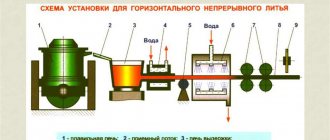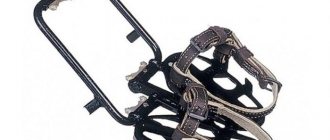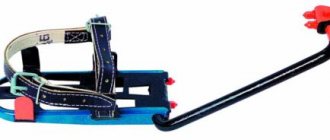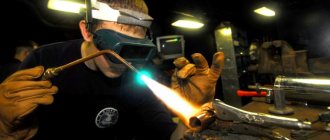Fitter's claws (fitter's manholes, crampons) are devices used by electricians and high-rise workers to safely climb concrete and wooden power line supports and trees. Despite the widespread use of specialized automobile towers and telescopic lifts, mounting claws still have a very large list of situations in which their use is more appropriate and convenient: when space is cramped and there is no possibility for equipment to approach power lines, when hydraulic mechanisms break down or fail lift at the work site.
Simple claw device
Design and principle of operation
The simplest manholes for concrete supports consist of 2 elements for attaching to shoes, each of which consists of the following main components:
- Oval foot support with transverse reinforcements;
- 2 straps holding the foot on the platform;
- “Sickle” is a rectangular grip with 4 conical spikes attached at an angle of approximately 600 to the supporting platform.
Climbing onto a reinforced concrete pole using a similar device occurs as follows:
- The electrician securely fixes the manholes on his shoes using belts;
- Approaching the pillar, he grabs it with the grips of each of the elements of the claws;
- The electrician climbs the pole, thanks to the fact that the claw grips, which he alternately rearranges in the vertical plane, located at an angle to the supporting platforms, bite into the concrete with their spikes and prevent slipping.
Using a similar principle, electrical claws designed for this type of support help you climb onto a wooden pole. Their only differences from the crampons used for concrete pillars are the semicircular shape of the grips and softer spikes.
Gaffs for climbing trees
What are gaffs?
Everyone has probably seen linemen climbing poles using special claws attached to their legs. This simple device has been known for a long time, but is intended for highly specialized activities, namely for servicing electrical networks. What if the task is to climb a tree? Unlike pillars, tree trunks are not the same in diameter and are covered with bark, which necessitates the use of slightly different devices. Gaffs are ideal for these purposes. What are gaffs? Simply put, these are spikes placed on the legs to make it easier to climb a tree. They are called differently - claws, cats, pikes, manholes and even pikes - dart climbers, but gaffs are more correct, from the English gaffs (although in the same English this device has no less synonyms - spurs, tree climbing spurs, tree climbing spikes). They are a durable strip of steel, aluminum, carbon or titanium, called a poker because its shape is similar to the letter G. A steel spike is attached to the bottom of the plate, which is stuck into the tree when climbing. The spikes are made removable for maintenance and replacement, as they come in different lengths: short, so-called pole spikes (about 44 mm in length) for climbing poles and trees with thin bark, and long ones - “wood” (about 70 mm in length) for climbing trees with thick bark. Pads are attached to the poker in the upper part - soft grips with belts made of leather or synthetic materials, which serve to securely fix the gaffs on the legs. At the moment, gaffs and components for them are produced by many companies, both foreign and domestic: Buckingham, Klein tools (America), Gecko (Germany), Drevorubec (Czech Republic), TreeUP (Poland), Tools (China), Krok, Bogatyr ( Ukraine), Maple, Lenstal (Russia). First of all, this equipment is in demand among arborists, because arboristry as a type of activity is directly related to climbing trees in order to remove certain branches or cutting down the entire tree in parts in cases where it is not safe to fell it in the usual way. However, there are various tasks associated with climbing trees, so gaffs can be very useful to hunters for setting up, as well as quickly and conveniently getting into blinds and storage sheds arranged in trees. Gaffs can also be useful for collectors of forest gifts, such as chaga or cones. Even ornithologists who study birds sometimes have a similar need for observation and recording. Considering such undoubted advantages as compactness and ease of use, gaffs can be recommended to anyone whose activities involve frequent climbing of trees.
Types of climbing cats
How to properly install street lighting
Depending on the design and purpose, all such devices are divided into claws for concrete pillars, manholes for wooden supports, dart climbers (devices used for climbing trees).
Manholes, claw-holes for reinforced concrete pillars
Catches for reinforced concrete pillars
This is the most common type of these devices, widely used by modern electricians and installers.
They consist of two oval support platforms with fastening straps for legs and rectangular grips up to 190-200 mm long, having 2 conical spikes on each of the short sides.
Claws for wooden posts
Crampons for wooden supports
Less common and less commonly used by modern electricians, manholes have one significant difference from the previous ones - their grips have a semicircular shape with a diameter of up to 220-315 mm and 5 spikes on each. The most famous model of such a device is the KM 1 brand claws.
Tree frogs
Tree frogs
Tree climbers have claws for climbing tree trunks. They are a curved “L”-shaped splint with a semicircular casing for the shin and a sharp triangular spike located on the outer part and a belt for fixing the foot. A similar device is used by high-altitude tree trimmers and hunters.
Areas of application of KLM2
Cats model KLM-2
Lazy claws marked KLM 2 are the most popular and widespread device. They are used for lifting reinforced concrete trapezoidal or rectangular supports with a diameter of up to 190 mm.
On a note. There is also a universal type of these devices, which has grips that allow you to climb most modern power transmission towers. The most famous model of such manholes is LU-2.
Essential equipment for every climber.
What you need will depend on your skill level and the reason for your vertical ambitions. Professionals will require a very different set of tools compared to the leisure enthusiast.
Buy a kit
A popular solution for many, even beginners, is to look for a kit that includes all the basic needs. This is enough to get you started and keep you safe as you explore your new hobby or possible profession. Some sets include a helmet, while others do not. The kit should at least include a strong harness, one or more carabiners and a strong rope. Everything else can be purchased separately so you can build up your collection over time rather than making a large one-time investment.
This entry-level incentive set is available in a variety of sizes, and you can expect the manufacturers to offer a sizing guide for your convenience.
As you can see, it includes the basic elements as well as some useful extras.
helmet
Head protection is important in a variety of sports and activities. Climbers should also wear a proper helmet at all times. You can't predict accidents. Whether a branch falls or you lose your grip and hit your head, the right helmet will minimize your injuries. Your helmet should fit you correctly. It doesn't have to be in your eyes when you're high on the ground or working with cutting tools.
This Petzl helmet is a popular product and you can even add a visor if you want. Visors are useful not only for protection from the sun's rays, but also from dust particles. Plus, since the viewfinder fits straight, you won't have to worry about the back of your ears falling off or becoming irritating.
Take advantage
Belts come in different models, colors and sizes. No matter what type of seat belt you choose, it is important that you inspect it and adjust it correctly to ensure it fits perfectly. You should never buy a pendant that suits you. You should be able to adjust in any way (less and more) in case you lose or gain weight in the future. The style will also determine how much support your suspension provides.
While some simple designs are lightweight and ideal for short periods of use, others may be a little heavier but will get you through a full day's work in the trees. The different clips also make it easy to fit extra tool bags and other supplies you might need once you're up and running. The last thing you want is to feel down every time you need something!
Weaver is a popular harness manufacturer, and this is just one of its many adjustable designs. If you purchase a leather harness, be sure to check with the manufacturer for care instructions. Different types of materials require different levels of attention and these instructions must be followed in writing for your safety.
carbines
Carabiners are an essential part of any climber's kit. Even if you're on a tight budget, it's worth investing in quality rather than looking for the cheapest option.
When shopping, be sure to choose carabiners that can support your weight comfortably and more. Double locking carabiners are some of the most difficult carabiners to use.
The auxiliary carabiners are not designed to carry very heavy weights, but are designed for quick and easy use. They don't have any kind of locking system, which means you can easily snap them and drop them. They are ideal for securing various tools and essential items for your climbing equipment.
Rope clamps are a popular alternative to carabiners. They are made from aluminum or steel and offer incredible support for climbing. When you go shopping, you will also find that specialty stores carry several shackles, links, and swivels. All of this is ideal for customizing your configuration. These are the types of accessories that you tend to accumulate over time, as you must first determine your preferences before you can make any customizations.
Petzl is an important name in the industry and so you can be sure to find a variety of carabiners and other similar clips.
Throw weights and lines
If you have ever tried to throw a rope over a branch, you will understand how difficult it is if there is nothing to guide the rope along its path. The correct weight at the end of the rope will help provide the necessary momentum to reach the desired height. The weight also helps ensure a smooth descent on the other side and reduces the effect that even a slight breeze can have on your otherwise accurate launch abilities.
Regarding strings, this is another corner that you can never afford to cut. It's not just about tensile strength. Of course, you need a rope that can support your weight, but it also needs to be resistant to sunlight. The ultraviolet rays from the sun can make normal strings brittle in a short time and this is extremely dangerous as it increases your chances of breaking. Your rope should also be resistant to twisting and flexible so that you can hold the knot correctly.
If you plan to spend only a few hours a week or a few hours a day climbing, you should look for a rope that won't hurt your hands. Braided ropes are ideal for comfort. No matter what type of rope you choose, it is always important to check it carefully before each use. The duration you choose will depend on your skill level and the purpose of your vertical adventures.
Cambium screensaver
Cambium savers are also known as friction savers. It is always important to be aware of your surroundings and the impact of your actions on nature. Even the smallest action can have a devastating reaction. You may not notice these reactions right away, but they will definitely go away after some time. When your rope rests on top of a branch and begins its climb, a lot of friction occurs.
The rope will rub against the tree bark and eventually it may wear down to the tree's cambium. That's how these products got their name! They were designed with conservation in mind, but they also offer much more.
By reducing friction, your rope will be less susceptible to wear and tear, meaning it will last longer. It is also useful to know that there are different types of cambium storage tanks and different sizes. The sleeve style is very popular as it slides right over the rope itself. If the thread is inside this U-shaped tube, it will not come into direct contact with the bark.
Ring styles are also popular and vary in length, ring size, thickness and more. There are even adjustable options, so you only need to take one to get the job done. More expensive options include pulley systems, cable guides and more. This Cambium Saver Leather Case is popular among beginners and experts.
Suitable clothing
Having fun outdoors is always more enjoyable when you wear the right clothes. The same can be said for working outdoors. There are many well-known clothing companies that specialize in tree climbing gear. Quality is extremely important, so even if you pay a little more, over time you will get more value for your service!
The first item you need to find is a pair of pants. They should allow free movement so that you don't have to worry about being stretched into slightly awkward positions while testing them. You can't afford to limit your range of motion when you're so high on the ground!
Pants with extra padding at the knees and crotch area are ideal. Remember that the belt will create some friction when it comes into direct contact with your pants, which is why a reinforced crotch area is so important. For those who feel comfortable in climbing shorts, they will find great durable designs from a variety of designers.
Quality boots are also essential as your leg and foot depend on traction and grip. The Highliner design is good for climbers, while the ankle boots are suitable for other climbing styles.
No matter what thread you use, you should always protect your hands. Depending on your needs and preferences, you can choose between medium work gloves and cut resistant gloves. Specialized rope control gloves provide protection without covering your fingertips, so you can still have full control of your equipment.
Hands are also optional for more protection. All other clothing, such as shirts and jackets, should be tight but stretchy to allow free movement.
Loose clothing will get in your way and can be dangerous. You should use reflective equipment if you work in areas such as high traffic areas, and it's always a good idea to have waterproof clothing in case you get caught in the rain.
It's also worth mentioning that arborist clothing isn't just for men! More and more women are joining this profession, and even those who are participating in activities are just to have fun. This growing interest among women has led to the design and creation of clothing lines specifically for women, and these products are equally durable.
Rules for using claws
Street lighting regulation
The procedure for using manholes consists of the following manipulations:
- When working on power lines, you must have the appropriate education and permission to repair such communications;
- When working on power lines, you must take care in advance to de-energize them;
- Before starting work, be sure to check the integrity of the retaining belts, support platforms for the feet, grips and the spikes located on them;
- It is advisable to work together - this is necessary so that in the event of an electric shock when working on an unpowered line or falling from a height if the technique of using claws is not followed, the second person can promptly provide first aid and call doctors.
Important! Manholes of a certain model and type can be used for certain supports specified in the passport. The use of such devices for lifting onto supports with a diameter larger than that specified in the passport is strictly prohibited.
Safety during work
Power line security zone
Both the installer and the other person using the claws must adhere to the following safety rules:
- In order to minimize the risk of falling, it is necessary to use a safety (safety) belt, with which the worker must fasten himself to the pole;
- To avoid electric shock and head injuries, it is imperative to use a protective helmet, special dielectric gloves, and overalls;
- The shoes to which the manholes are fastened must fit tightly on the feet: before putting on the manholes, they are carefully laced or fastened;
- Before you start lifting, be sure to check the stability of the support.
When using tree climbers, be sure to have a safety rope attached to a strong branch.
Understanding Potential Risks
No matter how large the climbing equipment or kits are in your tree, it is important to understand that this activity always poses at least some type of risk. The most common risk is a fall and subsequent injury. Other risks include encounters with hostile wildlife, poisonous insects and potentially toxic plants. To minimize these risks, you should follow these recommendations:
- Use only the correct equipment.
- Never use used equipment.
- Research the area where you will be climbing and determine if there are any risk factors for wildlife or plants.
- Inspect the tree you are about to take and look for any signs of damage, such as cracks in the wood, trunks that are excessively leaning, and any forms of infestation, rot, or decay.
- Look for weak branches and make sure you only use stable branches. If a tree has a lot of broken branches, this may indicate poor tree health.
- You should never climb on a dead tree unless you are a trained professional and it is your job to cut it down.
- If you are particularly sensitive to plants such as poison ivy, or if you are unsure of your sensitivity, it is recommended that you avoid areas where these plants grow.
- Always have first aid supplies on hand in case of emergency. Your standard first aid kit should be sufficient, but be sure to pack something specifically for skin irritations.
Equipment operating conditions
The use of manholes is permitted subject to the following conditions:
- Integrity of all elements: metal frame, support platforms, grips, holding belts;
- Mandatory verification of manholes - such equipment must be verified every two years in specialized laboratories. During the verification, the values of the strength characteristics of the main manhole structures declared are determined, and a conclusion is issued on the safety of using such equipment. The verified equipment must have a stamp indicating the date of verification;
- It is undesirable to use manholes of dubious origin: those that do not have manufacturer logos or initial verification marks;
- Requires appropriate education or training in the use of such equipment;
- Absence of foreign elements - for the safe use of factory models of manholes, it is prohibited to independently modernize them, replace structural elements and spikes with homemade ones.
All the details of working with manholes are described in special instructions for electricians and high-rise installers.
Defects in mounting claws
The main defects that can be found in an electrician's claws include the following:
- Cracks – such damage includes a violation of the integrity of the metal structures of the supporting platform, grip;
- Burrs are sharp edges of cracks in metal parts that, in contact with belts, can cause damage;
- Tears and fraying of retaining belts - with prolonged use, the material of the belts, gradually losing strength, begins to tear and separate into fibers, which is visually manifested in the form of terryness and clearly visible transverse tears;
- Deformation and reduction in the strength of the studs - caused by natural fatigue of the metal, this defect manifests itself in the partial or complete loss of this element of its main functions.
Note! If one of the above-described defects is detected in factory-made models, experts recommend not to repair them yourself, but to take them to a specialized workshop for repairs. It is prohibited to use such installation equipment even with minimal damage.
Proper storage conditions
After each use, the claws must be cleaned of dirt, rust, concrete dust or crumbs.
Claws for climbing poles should be stored suspended (on hooks or special hangers), in well-ventilated, dry areas out of the reach of children and pets.
Another advantage of such equipment for installers and electricians is the possibility of making it yourself - on the Internet you can easily find both a visual drawing and video instructions for assembling claws from scrap materials with your own hands.
Junior climbers
This activity is not only for adults or professionals. Children can really benefit from time outdoors, and research has shown that children do need some 'risky' play. Of course, safety should always come first and you never want to put your baby in danger. There are some great junior tree climbing kits and gear available.
These kits are usually reasonably priced and include the basics to get your baby off to a safe start. As parents know, children grow so quickly that spending too much money on something that will likely grow within a few months is relatively futile.
When you buy this type of kit, it is important to know your child's weight and height. Always buy equipment that can support more than your child's current weight and, if possible, purchase larger equipment that can be adjusted to fit. It is important that your child checks the equipment to make sure it is snug but not uncomfortable.










